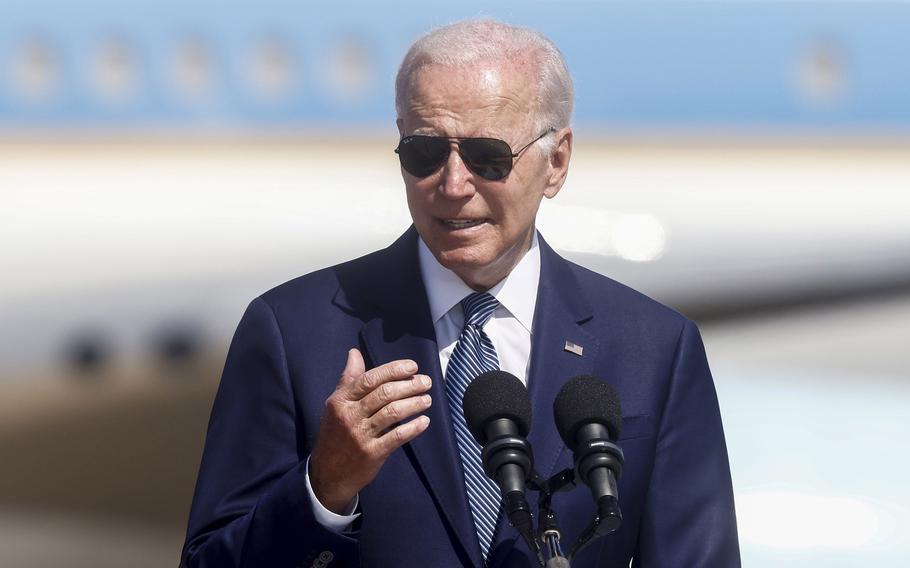
U.S. President Joe Biden, speaks during an arrival ceremony at Ben Gurion International Airport in Tel Aviv, Israel, on July 13, 2022. (Kobi Wolf/bloomberg)
The political outlook heading into the final month of the campaign is muddled, to say the least. Inflation is near record highs, which is bad news for incumbent Democrats. On the other hand, abortion rights are under siege across the country, which is an issue that works in Democrats’ favor. Meanwhile, a former president who is the subject of various criminal and civil investigations nevertheless has the Republican Party in a stranglehold.
All this raises the question: Which issue do voters care about most? To get an answer, I decided to follow the money. The advertising money, that is.
It may seem an odd thing to say about advertising, but in this context, it can provide some clarity. Yes, there are polls that rank voters’ top concerns, and of course politicians always claim to have their finger on the pulse of the electorate. But how they spend their money is a better indicator. It’s a window into what they’re seeing on the ground and what their polls are telling them.
I examined data on some Senate races provided by Bully Pulpit Interactive’s Political Ad Tracker. The firm is run by veteran Democratic strategists, but its platform tracks ad spending by candidates and outside groups from both parties.
In the Ohio Senate race, for example, where the two candidates are running pretty even, Democrat Tim Ryan is trying to put the opioid crisis front and center while Republican J.D. Vance is trying to rally the base by glorifying former President Donald Trump and vilifying Democrats.
Through the summer and early September, roughly 20% of Ryan’s ads on Meta, which includes Facebook and Instagram, focused on the opioid epidemic. He’s running TV ads attacking Vance on an opioid nonprofit group he founded with ties to the pharmaceutical industry. According to the Bully Pulpit data, Vance’s Meta ads over the same period have focused on his alliance with Trump and on attacking Democrats as socialists. Ryan has spent more than $1 million on Meta ads, compared to less than $14,000 for Vance.
Notably, Ryan — and other candidates — aren’t spending a lot on ads about abortion. Why? In part because it’s a nuanced topic that outside groups can speak to and fund more effectively, says Paulette Aniskoff, a partner at Bully Pulpit.
It’s also what’s known as a “mobilizing” issue — meaning it helps Democrats organize their base — as opposed to a “persuasion” issue. Topics that persuade undecided voters tend to be economic, such as health care and inflation. The Dobbs decision has certainly mobilized the Democratic base, but without a 60-vote majority in the Senate, Democrats won’t be able to codify Roe v. Wade. If Democratic Senate candidates want to persuade voters, says Aniskoff, they’d be better off focusing on their accomplishments, such as the Inflation Reduction Act.
When it comes to the economy, Democratic candidates won’t run specifically on the IRA, but they will highlight specific parts of the bill. So in Georgia, for example, Sen. Raphael Warnock is running TV ads highlighting the solar manufacturing funded by the law, which he supported.
In Wisconsin, incumbent Republican Sen. Ron Johnson and his opponent are spending time and money talking about crime. On TV, Johnson is hitting Democratic Lt. Gov. Mandela Barnes as a “radical leftist” who wants to defund the police and release criminals without bail. Barnes is responding with his positions on community safety and policing.
Bully Pulpit data shows Johnson focusing roughly half of his spending on Meta on immigration, the economy and attacks on President Joe Biden, while Barnes’ top spending topic is criminal justice reform. Other issues for Barnes include tax fairness and excessive corporate power.
In North Carolina, Republican Rep. Ted Budd is focusing his Meta ads on Biden and the economy, while Democrat Cheri Beasley’s emphasize issues such as the Supreme Court and filibuster reform. In one ad, about Medicare, Beasley attacks Budd for taking money from drug companies. Two-thirds of her ads are aimed at women, according to Bully Pulpit, and many highlight Budd’s pro-life position.
Granted, these ads provide just a snapshot. But it’s clear that, so far at least, Democratic candidates are focusing on persuasion issues, with reproductive rights as a parallel message around which to organize. Republican candidates are focusing on mobilizing issues such as immigration and crime. The economy remains an issue for both sides.
So, if you’re trying to figure out which are the most salient issues for voters this year, the unsatisfying answer is this: It depends on who’s talking — and where.
Julianna Goldman is a Bloomberg Opinion columnist who was formerly a Washington-based correspondent for CBS News and White House correspondent for Bloomberg News and Bloomberg Television. This column does not necessarily reflect the opinion of the editorial board or Bloomberg LP and its owners.